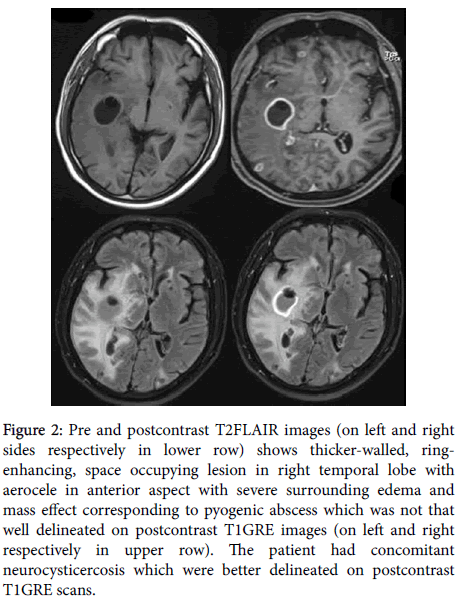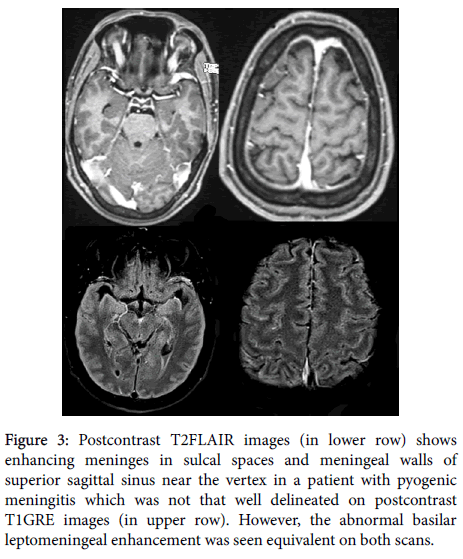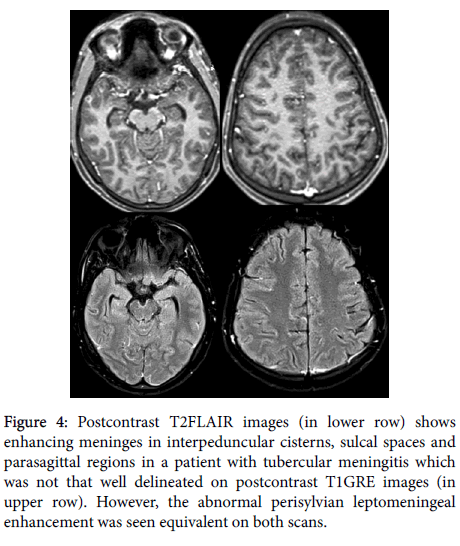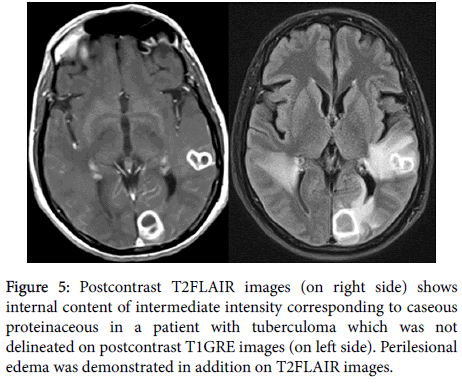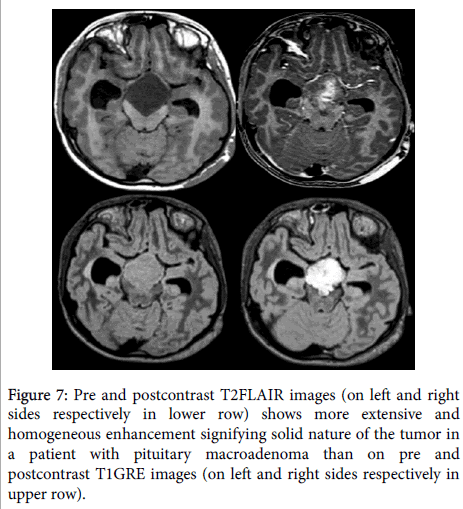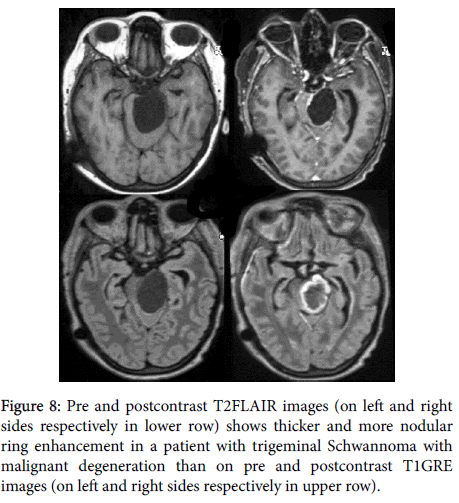Research Article Open Access
Can Postcontrast-T2FLAIR be a Boon over Postcontrast-T1GRE Images in MR Brain Imaging?
Rajul Rastogi1*, Sujeet Jain2, Yuktika Gupta1, Pawan Joon1, Asif Majid Wani1 and Vijai Pratap
1Teerthanker Mahaveer Medical College and Research Center, Moradabad, UP, India
2School of Medical Science and Research, Greater Noida, UP, India
- *Corresponding Author:
- Rajul Rastogi
Teerthanker Mahaveer Medical College
and Research Center, Moradabad, UP, India
Tel: 09658792858
E-mail: eesharastogi@gmail.com
Received date: May 10, 2016; Accepted date: June 04, 2016; Published date: June 06, 2016
Citation: Rastogi R, Jain SK, Gupta Y, Joon P, Wani AM, et al. (2016) Can Postcontrast-T2FLAIR be a Boon over Postcontrast-T1GRE Images in MR Brain Imaging?. J Neuroinfect Dis 7:219. doi:10.4172/2314-7326.1000219
Copyright: © 2016 Rastogi R, et al. This is an open-access article distributed under the terms of the Creative Commons Attribution License, which permits unrestricted use, distribution, and reproduction in any medium, provided the original author and source are credited.
Visit for more related articles at Journal of Neuroinfectious Diseases
Abstract
We are all familiar with the role of postcontrast-T1GRE images in MR brain imaging especially in the presence of space occupying lesions. But very few are aware of the role of postcontrast-T2FLAIR images in similar circumstances. Though T2-effect of gadolinium and T1-effect of T2FLAIR has been established for long yet it has not been utilized intensively and extensively in practice. However, there have been few isolated studies establishing the role of postcontrast-T2FLAIR images in variety of brain pathologies. In this study, we aim to evaluate the role of postcontrast-T2FLAIR images in various pathological conditions of brain in wider spectrum and evaluate its usefulness in comparison with postcontrast T1GRE images in clinical practice.
Keywords
Brain; Gadolinium; T2FLAIR; T1GRE
Introduction
Gadolinium-chelates are frequently used to evaluate a variety of pathological conditions of brain during magnetic resonance imaging (MRI). Pre and postcontrast T1-gradient recalled echo (T1GRE) scans are usually compared for assessing the various characteristics of lesions as vascularity, internal necrosis or breach in blood brain barrier.
Postcontrast T1GRE scans utilizes the T1-shortening effect of gadolinium for conspicuous delineation of variety of lesions. In addition to T1-shortening, gadolinium also produces T2-shortening effect which is inversely proportional to gadolinium concentration resulting in increased contrast to noise ratio [1].
However, the post-gadolinium enhancement seen on T2-fluid attenuated inversion recovery (T2FLAIR) images is because of the T2- prolongation effect of various lesions and T1-shortening effect of gadolinium acting in synergism [2]. In this article, we share our experience on postcontrast-T2FLAIR images versus postcontrast- T1GRE images in variety of brain pathologies.
Material and Methods
Approximately twenty patients visiting the department of Radiodiagnosis with clinical suspicion of brain pathologies were randomly selected for our study. All the selected patients underwent noncontrast and postcontrast MRI brain examinations.
Although multiple sequences were used to achieve the final diagnosis but we included noncontrast and postcontrast T1GRE and T2FLAIR images, both acquired on 1.5T magnet system with a highresolution matrix. Postcontrast-T1GRE scans preceded postcontrast- T2FLAIR images, thus producing an inherent delay of 4-5 minutes in the two postcontrast sequences.
All the acquired images were examined and findings on postcontrast-T2FLAIR images were recorded first followed by postcontrast-T1GRE scans by a single radiologist. A separate mention was made of the findings exclusively recorded on postcontrast- T2FLAIR images.
Observations
Out of twenty patients, four patients were excluded from the study due to suboptimal scan quality as the patients could not be sedated adequately at the time of examination due to clinical limitations resulting in significant motion during scanning.
Out of remaining sixteen patients, two had neurocysticercosis; two had pyogenic abscess; four had only meningitis; four had tuberculoma (two with accompanying meningitis) and four patients had different intracranial tumors.
Patients ranged from 15-50 years of age with equal number of male and female subjects.
In patients with neurocysticercosis, postcontrast-T2FLAIR did not reveal any additional finding. In fact, the lesion was better demonstrated on postcontrast-T1GRE scans (Figure 1).
In patients with pyogenic abscess, the air within the abscess was seen with more conspicuity on postcontrast-T2FLAIR images than on postcontrast-T1GRE images with greater enhancing-mural thickness appreciated on the T2FLAIR images (Figure 2). Demonstration of air within the lesion is a specific indicator of pyogenic etiology especially anaerobic and thickness of wall is an indicator of stage of abscess and may predict surgical removal.
Figure 2: Pre and postcontrast T2FLAIR images (on left and right sides respectively in lower row) shows thicker-walled, ringenhancing, space occupying lesion in right temporal lobe with aerocele in anterior aspect with severe surrounding edema and mass effect corresponding to pyogenic abscess which was not that well delineated on postcontrast T1GRE images (on left and right respectively in upper row). The patient had concomitant neurocysticercosis which were better delineated on postcontrast T1GRE scans.
In patients with meningitis, detection of extent of abnormal meningeal enhancement was more on postcontrast-T2FLAIR images with similar or more-measurable thickness than noted on postcontrast-T1GRE images (Figures 3 and 4). Extent of meningitis and thickening of meninges is linked to etiology and may indicate further course of action for example en plaque meningioma or meningeal metastases have different treatment than chronic meningitis noted in tubercular disease where extent or meningeal thickness is a criteria of diagnosis.
Figure 3: Postcontrast T2FLAIR images (in lower row) shows enhancing meninges in sulcal spaces and meningeal walls of superior sagittal sinus near the vertex in a patient with pyogenic meningitis which was not that well delineated on postcontrast T1GRE images (in upper row). However, the abnormal basilar leptomeningeal enhancement was seen equivalent on both scans.
Figure 4: Postcontrast T2FLAIR images (in lower row) shows enhancing meninges in interpeduncular cisterns, sulcal spaces and parasagittal regions in a patient with tubercular meningitis which was not that well delineated on postcontrast T1GRE images (in upper row). However, the abnormal perisylvian leptomeningeal enhancement was seen equivalent on both scans.
In patients with tuberculoma, the nature of internal contents as well as the number of lesions along with extent of perilesional edema was better delineated on postcontrast T2FLAIR images than on postcontrast T1GRE images (Figures 5 and 6). Delineation of CSFintense internal contents may indicate cysticercus or other cystic lesions with internal transudative content while presence of more intense internal content favour proteinaceous or cellular contents as noted in tuberculoma or necrotic tumors.
Figure 5: Postcontrast T2FLAIR images (on right side) shows internal content of intermediate intensity corresponding to caseous proteinaceous in a patient with tuberculoma which was not delineated on postcontrast T1GRE images (on left side). Perilesional edema was demonstrated in addition on T2FLAIR images.
Figure 6: Postcontrast T2FLAIR images (in lower row) shows more number and larger size of enhancing lesions in cerebellum but more marked in pontine region with better detection of abnormal meningeal enhancement in a patient with tuberculoma and tubercular meningitis than on postcontrast T1GRE images (in upper row).
In patients with tumors, postcontrast T2FLAIR images show more extensive enhancement (corresponding to solid part) and thicker and more nodular wall enhancement in necrotic tumor than on postcontrast T1GRE images (Figures 7 and 8). These findings not only determine the differential diagnosis among tumors but also help in deciding the site of stereotactic biopsies to reach the final diagnosis.
Figure 7: Pre and postcontrast T2FLAIR images (on left and right sides respectively in lower row) shows more extensive and homogeneous enhancement signifying solid nature of the tumor in a patient with pituitary macroadenoma than on pre and postcontrast T1GRE images (on left and right sides respectively in upper row).
Figure 8: Pre and postcontrast T2FLAIR images (on left and right sides respectively in lower row) shows thicker and more nodular ring enhancement in a patient with trigeminal Schwannoma with malignant degeneration than on pre and postcontrast T1GRE images (on left and right sides respectively in upper row).
Discussion
T2FLAIR image sequence is an inversion recovery sequence acquired with long TR (time to repetition), long TE (time to echo) and inversion time (TI) that effectively suppresses the signal from CSF at all locations including sulcal spaces allowing better detection and delineation of extent of the lesions lying adjacent to meninges especially sulcal spaces as variable hyperintensities. Though T2FLAIR images are heavy T2-weighted, yet their mild T1-weighting is also responsible for better delineation of lesions on postcontrast-T2FLAIR images making it a highly sensitive sequence in detecting meningeal inflammation, infections and carcinomatosis.
Many studies have concluded that postcontrast T2FLAIR images are more sensitive than both postcontrast-T1GRE and noncontrast T2FLAIR images especially in detections of subtle and smaller cortical and deeper lesions for example leptomeningeal carcinomatosis which is devoid of mass effect as seen in our study [3-5]. In deeper lesions, the contrast between the enhancing lesion and surrounding vasogenic edema is superior than that seen on noncontrast T2FLAIR images (Table 1).
| S.No. | Disease | Number of Patients |
|---|---|---|
| 1 | Neurocysticercosis | 2 |
| 2 | Pyogenic abscess | 2 |
| 3 | Meningitis | 4 |
| 4 | Tuberculoma | 4 |
| 5 | Tumors | 4 |
| Total | 16 |
Table 1: Distribution of disease with number of patients in the study group.
Meningeal enhancement detected on postcontrast T2FLAIR images can help in detecting subtle traumatic brain lesions as well as additional lesions in symptomatic post-traumatic patients with otherwise normal MRI brain [2]. Normal meningeal enhancement is thin, linear and discontinuous but thick, linear and continuous meningeal enhancement is considered abnormal arising secondary to increased water content of dura mater that can be seen with variety of benign and malignant conditions including intracranial hypotension, post-traumatic (including post-surgical) condition, inflammatory conditions including granulomatous diseases and infections and metastases [2,6-10]. In fact, some studies have concluded that doubledose; postcontrast 3D-T2FLAIR images may be complementary to postcontrast-3D-T1GRE images in detections of small brain metastases [11].
Studies have also demonstrated that postcontrast T2FLAIR images can detect variable degrees of CSF changes in variety of brain pathologies [12].
Better demonstration of internal nature of tuberculoma and tumors; walls of abscesses and tumors and enhancing meninges of dural venous sinuses by postcontrast-T2FLAIR images than with postcontrast- T1GRE scans have not been studies in previous studies. Inclusion of neurocysticercosis was also not noted in previous studies.
Limitations of the Study
The major limitation is the small number of patients that were included in the study. Another limitation is non-representation of other brain pathological conditions where postcontrast scans may provide additional information viz. demyelinating and dysmyelinating diseases.
Minor limitations include the slight increase in scan time, higher post-injection delay in acquisition of postcontrast-T2FLAIR images and clinical implications of the additional information recorded.
Conclusions
Based on the systematic analysis of the imaging findings in the above study group following conclusions can be drawn:
• Postcontrast-T1GRE images are superior to postcontrast-T2FLAIR images in delineating degenerating cysts of cysticerci.
• Postcontrast-T2FLAIR images are superior to postcontrast-T1GRE images in demonstrating internal air and perilesional edema simultaneously in addition to wall enhancement with greater mural thicker in patients with pyogenic abscesses.
• Postcontrast-T2FLAIR images are superior to postcontrast-T1GRE images in determining the extent of meningeal enhancement especially in sulcal spaces (especially in tubercular meningitis) and dural sinuses due to presence of luminal signal void of sinus lumen on T2FLAIR images.
• Postcontrast-T2FLAIR images are superior to postcontrast-T1GRE images in determining the nature of internal contents and number of lesions in cases of tuberculoma with an additional advantage of demonstrating edema.
• Postcontrast-T2FLAIR images are superior to postcontrast-T1GRE images in determining the nature of internal contents and mural characteristics in cases of intracranial tumors.
• Finally, postcontrast-T2FLAIR images may obviate the need for noncontrast-T2FLAIR images. Also if postcontrast-T2FLAIR images are normal, then postcontrast-T1GRE images are unlikely to be abnormal while if postcontrast-T2FLAIR images are abnormal than pre and postcontrast-T1GRE images may tell us whether the increased signal intensity on postcontrast-T2FLAIR images is due to T1- shortening effect of gadolinium or T2-prolongation effect of brain pathology.
Summary
To summarize, postcontrast-T2FLAIR images may be routinely used as an additional tool to postcontrast-T1GRE scans in MRI examination of a variety of brain pathological conditions as it provides additional clinically useful information that may be helpful in management and predicting prognosis except in cases of neurocysticercosis. However, more studies preferably with larger number of patients and wider spectrum of brain pathologies may be required to validate the results of this study in routine clinical practice.
Acknowledgements
I am extremely thankful to all my MRI technologists viz. Mr. Francis Randhawa, Mr Hanook Lawrence, Mr. Navneet Singh and Mr. Rohit Frank who took tiring efforts in acquiring and achiving of MR images.
References
- Lee MJ, Kim MJ, Yoon CS, Song SY, Park K, et al. (2011) The T2-shortening effect of gadolinium and the optimal conditions for maximizing the CNR for evaluating the biliary system: a Phantom study. Korean J Radiol 12: 358-364.
- Kim SC, Prak SW, Ryoo I, Jung SC, Yun TJ, et al. (2014) Contrast-enhanced FLAIR (Fluid-attenuated Inversion Recovery) for evaluating mild traumatic brain injury. PLoS One 9: e102229.
- Ercan N, Gultekin S, Celik H, Tali TE, Oner YA, et al. (2004) Diagnostic value of contrast-enhanced fluid-attenuated inversion recovery MR imaging of intracranial metastases. AJNR Am J Neuroradiol 25: 761–765.
- Mathews VP, Caldemeyer KS, Lowe MJ, Greenspan SL, Weber DM, et al. (1999) Brain: gadolinium-enhanced fast fluid-attenuated inversion-recovery MR imaging. Radiology 211: 257–263.
- Fukuoka H, Hirai T, Okuda T, Shigematsu Y, Sasao A, et al. (2010) Comparison of the added value of contrast-enhanced 3D fluid-attenuated inversion recovery and magnetization-prepared rapid acquisition of gradient echo sequences in relation to conventional postcontrast T1-weighted images for the evaluation of leptomeningeal diseases at 3T. AJNR Am J Neuroradiol 31: 868–873.
- Smirniotopoulos JG, Murphy FM, Rushing EJ, Rees JH, Schroeder JW (2007) Patterns of contrast enhancement in the brain and meninges. Radiographics 27: 525–551.
- Sze G (1993) Diseases of the intracranial meninges: MR imaging features. AJR Am J Roentgenol 160: 727-733
- Dolinskas CA, Simeone FA (1998) Surgical site after resection of a meningioma. AJNR Am J Neuroradiol 19: 419–426.
- Henegar MM, Moran CJ, Silbergeld DL (1996) Early postoperative magnetic resonance imaging following non-neoplastic cortical resection. J Neurosurg 84: 174-179.
- Kremer S, Abu Eid A, Bierry G, Koob M, Dietemann JL, et al. (2006) Accuracy of delayed postcontrast FLAIR MR imaging for the diagnosis of leptomeningeal infectious or tumoral diseases. Journal of Neuroradiology 33: 285-291.
- Ahn SJ, Chung TS, Chang JH, Lee SK (2014) The added value of double dose gadolinium enhanced 3D T2 fluid-attenuating inversion recovery for evaluating small brain metastases. Yonsei Med J 55: 1231-1237.
- Bozzao A, Floris R, Fasoli F, Fantozzi LM, Colonnese C, et al. (2003) Cerebrospinal fluid changes after intravenous injection of gadolinium chelate: assessment by FLAIR MR imaging. EurRadiol 13: 592-597.
Relevant Topics
- Bacteria Induced Neuropathies
- Blood-brain barrier
- Brain Infection
- Cerebral Spinal Fluid
- Encephalitis
- Fungal Infection
- Infectious Disease in Children
- Neuro-HIV and Bacterial Infection
- Neuro-Infections Induced Autoimmune Disorders
- Neurocystercercosis
- Neurocysticercosis
- Neuroepidemiology
- Neuroinfectious Agents
- Neuroinflammation
- Neurosyphilis
- Neurotropic viruses
- Neurovirology
- Rare Infectious Disease
- Toxoplasmosis
- Viral Infection
Recommended Journals
Article Tools
Article Usage
- Total views: 12278
- [From(publication date):
June-2016 - Apr 07, 2025] - Breakdown by view type
- HTML page views : 11318
- PDF downloads : 960


